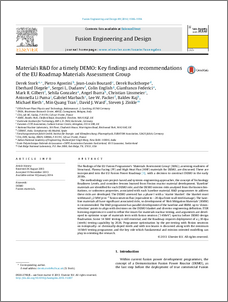Stork, Derek and Agostini, Pietro and Boutard, Jean-Louis and Buckthorpe, Derek and Diegele, Eberhard and Dudarev, Sergei L and English, Colin and Federici, Gianfranco and Gilbert, Mark R and Gonzalez, Sehila and Ibarra, Angel and Linsmeier, Christian and Puma, Antonella Li and Marbach, Gabriel and Packer, Lee W and Raj, Baldev and Rieth, Michael and Tran, Min Quang and Ward, David J and Zinkle, Steven J
(2014)
Materials R&D for a timely DEMO: Key findings and recommendationsof the EU Roadmap Materials Assessment Group.
Fusion Engineering and Design, 89 (7).
pp. 1586-1594.
![[img]](http://eprints.nias.res.in/style/images/fileicons/application_pdf.png)  Preview |
|
PDF
2014-BaldevRaj-Fusion_Enginnering_and_Design.pdf
Download (1MB)
|
| Abstract: |
The findings of the EU Fusion Programme’s ‘Materials Assessment Group’ (MAG), assessing readiness ofStructural, Plasma Facing (PF) and High Heat Flux (HHF) materials for DEMO, are discussed. These areincorporated into the EU Fusion Power Roadmap [1], with a decision to construct DEMO in the early2030s.The methodology uses project-based and systems-engineering approaches, the concept of TechnologyReadiness Levels, and considers lessons learned from Fission reactor material development. ‘Baseline’materials are identified for each DEMO role, and the DEMO mission risks analysed from the known lim-itations, or unknown properties, associated with each baseline material. R&D programmes to addressthese risks are developed. The DEMO assessed has a phase I with a ‘starter blanket’: the blanket mustwithstand @le;2 MW yr m−2fusion neutron flux (equivalent to ∼20 dpa front-wall steel damage). The base-line materials all have significant associated risks, so development of ‘Risk Mitigation Materials’ (RMM)is recommended. The R&D programme has parallel development of the baseline and RMM, up to ‘down-selection’ points to align with decisions on the DEMO blanket and divertor engineering definition. ITERlicensing experience is used to refine the issues for materials nuclear testing, and arguments are devel-oped to optimise scope of materials tests with fusion neutron (‘14 MeV’) spectra before DEMO designfinalisation. Some 14 MeV testing is still essential, and the Roadmap requires deployment of a ≥30 dpa(steels) testing capability by 2026. Programme optimisation by the pre-testing with fission neutronson isotopically- or chemically-doped steels and with ion-beams is discussed along with the minimum14 MeV testing programme, and the key role which fundamental and mission-oriented modelling canplay in orienting the research. |
| Item Type: |
Journal Paper
|
| Additional Information: |
Copyright belongs to Publisher |
| Subjects: |
General > Directors > Baldev Raj > Publications |
| Divisions: |
Schools > Natural Sciences and Engineering |
| Date Deposited: |
09 Sep 2015 11:36 |
| Last Modified: |
27 Oct 2015 05:56 |
| Official URL: |
http://ac.els-cdn.com/S0920379613007059/1-s2.0-S09... |
| Related URLs: |
|
| Funders: |
UNSPECIFIED |
| Projects: |
UNSPECIFIED |
| DOI: |
10.1016/j.fusengdes.2013.11.007 |
| URI: |
http://eprints.nias.res.in/id/eprint/671 |
Actions (login required)
 |
View Item |


